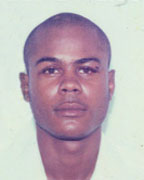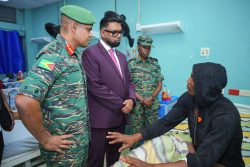-families of chain snatcher, alleged traffic HQ thief aggrieved
The shooting to death of suspected lawbreakers by the police and vigilante justice meted out by licensed firearm holders have again raised the issue of the erosion of human rights.
Relatives of two men who died recently after they were shot while escaping after reportedly stealing items are questioning the shooters’ decision to fire and whether this was in fact legal. Chain snatcher Gavin Paul and alleged Traffic Headquar-ters thief Keith Mitchell both died after they were shot – one by a private citizen the other by the police.
In addition, observers have pointed to the ill-treatment of suspects when apprehended by the police or public-spirited citizens, as being objectionable. Suspects, especially those accused of simple larceny, larceny, larceny from person and other variations of the charge, often complain to the court about the “beatings” they receive before being handed over to the police and while in custody as well.

Paul, 20, of Hill Street, Albouystown, Georgetown reportedly snatched a woman’s gold chain at North Road and Alexander Street on June 6. After committing the act, reports had said, Paul ran into North Road and darted through several yards jumping fences before entering an alley between North Road and Robb Street. He was pursued by a group of public-spirited citizens, which included the man who eventually fatally shot him.
After relatives insisted that the shooter be charged Crime Chief Seelal Persaud had reported that police were unable to identify the private citizen who shot Paul.
Paul’s mother, Winola Baptiste, said police have not been taking her son’s case seriously. A nickname, the woman said, was all they had managed to get for the shooter so far.
“I can’t forget the inhumane treatment my son got,” Baptiste said. “How could they stand there and watch a thief yes, but my son and a human being, die? Where were their hearts and compassion?”
Baptiste said she will always remember the “inhumane” treatment given to her son the morning he died. The woman admitted that her son had been associating “with the wrong friends” before his death. Struggling to hold back the tears, she said her son might have stolen but such an offence did not deserve the death penalty.
“Even if my son de thief a gold chain,” Baptiste said, “they shouldn’t beat he like that and then shoot he… Dey shoulda let de police deal with he.”
Paul was perhaps shot as he moved through the alley into which he had fled. Despite being wounded he continued his vain attempt to escape and exited the alley, bleeding and ran into Robb Street still chased by the group. He finally collapsed in front of the Courtyard Mall. It had been raining that morning and as Paul’s blood washed into a nearby drain he pleaded to be taken to the hospital. An argument erupted between citizens who had gathered around the man.
As persons stood on the pavement, peered out windows and leaned over balconies to see “the drama” Paul was slowly dying. Persons were said to be undecided as to how to treat him. While some sympathized saying that Paul was human and “needed immediate assistance to the hospital” others condemned him over the robbery and said that he had to remain on the pavement until the police arrived.

Baptiste said that shortly after her son’s death she and other relatives visited the areas where he was last seen. Residents around the North Road/Alexander Street area, Baptiste reported, said that Paul received “a severe beating” after he had snatched a chain from Alana Butcher.
“The people from around the area who saw some of what happened were afraid to talk to us,” Baptiste said. “Because they said they didn’t want to get involved in anything but I beg them to tell me what happened to my son because it was important for me to know… I realize that knowing would hurt but the truth almost always does.”
Paul, residents told his still grieving mother, was given “a good thrashing” shortly before his death. Her son, she was informed by witnesses, lost his shirt during his attempt to escape the scene. Butcher, the woman was told, had raised an alarm and as several persons responded and began grabbing Paul the robbery victim left.
Paul was beaten by three persons for a few minutes and made several attempts to escape.
“They [residents] told me that he appeared almost delirious that it was in his bid to escape the beating he got that he ran into that alley where he was shot,” she said.
Keith Mitchell
Mitchell, of Lot 17 Lombard and Broad streets, Georgetown, died shortly after he was shot in the left thigh by police early in the morning of May 7 at Anira Street. Reports were that Mitchell had stolen a number of items from Police Traffic Headquarters, Eve Leary. He was detected by ranks as he attempted to escape with his booty and a chase, which ended at Anira Street, ensued.
The man’s relatives had said they were not satisfied with the details provided to them by police.
Efforts made since May 8 to contact Traffic Chief Neil Semple about the matter have been futile. Questions about the chase to Anira Street and the level of security at Traffic Headquarters the morning it was reportedly breached by Mitchell remain unanswered.
Mitchell’s mother, Leotha Crandon, believes that her son was beaten by police before being taken to the Georgetown Public Hospital (GPH). Crandon said that she learnt from GPH staff that her son was still alive when he arrived at the medical institution but doctors were unable to save him.
A post-mortem conducted on her son, the woman said, revealed that he bled to death. A relative who identified Mitchell’s body, Crandon recalled, had reported that there were visible marks of violence which led them to believe that he was beaten by police before or after he was wounded.
Police, in a press statement issued shortly after had said the Anira Street, Queenstown incident occurred around 4.45 am that day. Mitchell, police had alleged, had stolen a windscreen off a minibus that was lodged in the compound at Traffic Headquarters and was subsequently shot in his left thigh by a policeman.
Mitchell, according to police, had been seen earlier riding a bicycle in the vicinity of Traffic Headquarters. He was subsequently seen leaving the Traffic Headquarters compound with a front windscreen that had been taken off a minibus. Ranks on duty challenged him but he ran away. The man was pursued and the policemen caught up with him at Anira Street, “and during efforts to arrest him he was shot to his left upper thigh by one of the ranks who was armed with a service firearm”.
Crandon said she and another son had approached police about the matter. They had asked the Criminal Investigation Department rank investigating the matter to see the windscreen which was recovered by police and whether the item had been checked for finger prints.
“The CID man [named] told us that they had the windscreen and that they had already checked for finger prints and done the necessary…I don’t know where to go and what else to do,” a frustrated Crandon said.
‘…to shoot or
not to shoot?’
Both mothers, still grieving for their sons, are insisting that they should not have been shot under such circumstances. Mitchell and Paul were both shot while fleeing and neither was afforded immediate medical attention.
“I ask de police and up to now I can’t get a proper answer,” Baptiste said, “I want them to tell me if the man that shoot meh son [Paul] was right to do so because as far as I know meh son never threaten or attack he. How does these licensed firearm holders and police decide to shoot or not to shoot?”
Stabroek News was unable to get any senior officials from the Guyana Police Force to speak about guidelines which help armed ranks decide when to used firearms.
In their press release on the Mitchell matter, police did not indicate whether the alleged thief had attacked the two ranks pursuing him that morning.
Meanwhile, an information sheet given to licensed firearm holders by the police lists general principles to be followed and indicates four situations in which the armed person may fire. Stabroek News was unable to ascertain whether the same guidelines apply to armed members of the Guyana Police Force.
The information sheet, under the heading “When you may fire”, states “When anyone is found committing or about to commit a felony, e.g ‘Murder, Dangerous Violence To A Person, Robbery, Burglary, Shop Breaking, Store Breaking, House Breaking, Arson or Larceny’ and does not desist after warning and cannot be deterred or arrested by any other means”.
Licensed firearm holders may also fire when attacked, if they sustain serious danger to their person and are unable to defend themselves by other means; and when the property they are ordered to defend is attacked and they are unable to defend it by other means.







